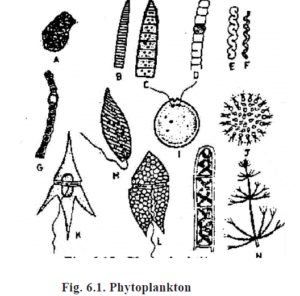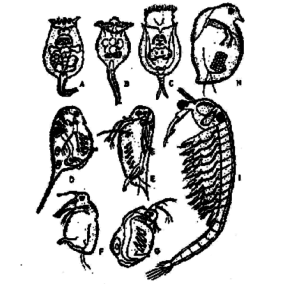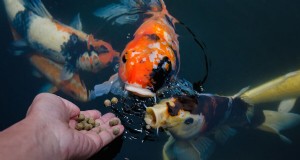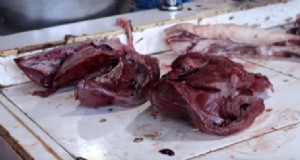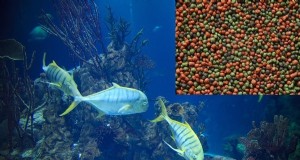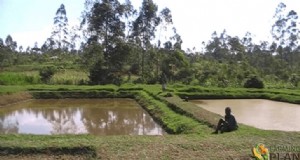私 ndi NS ati o NS o NS NS lga l co l ラップ NS
水の色の強度の増加–水面の色のクラスター–発泡/泡立ちのある水柱のミルククラウド–水の浄化–透明度の劇的な増加。
NS NS o ce NS あなたは e NS NS e ナン NS の NS ポン NS 予定 k に NS ポプ l 比率 NS
次の手順の準備中に提案されています:
Water may be filled upto 50 cm depth – Fertilisation may be done with 9 kg urea and 0.9 kg TP (Total phosphorus) – Pond may be temporarily sealed till dark brown colour with yellowish colouration appears- Water may be filled upto 80% of the operational level and 14kg urea and 1.4kg TP may be applied – Pond kept undisturbed for 2/3 days-(If no colouration develops 50-100kg/ha CaCo3 may be applied) – Pond filled to operational level – 19 kg urea and 3kg TP per ha may be applied – If yellowish-brown coloration does not appear water level may be dropped by 10cm and refertilised with 6.8 kg urea and 0.7 kg TP.
After 5 days, a Secchi disc reading of 25-35 cm and a yellowish-brown water coloration confirm optimal condition for best stocking results.
Nutritional value of plankton (fish food organisms):As discussed earlier, due to their balanced nutritional aspects, fish food organisms are rightly referred to as ‘living capsules of nutrition’ and more often so as single cell protein.しかし、 the nutritional values of each organism greatly vary according to the culture conditions as well as the phase of growth during the harvest. As for example, harvest at prime phase of microalgae contains high protein and at stationary phase, higher carbohydrate. The proximate composition and nutritional details of some natural food groups of the plankton species (Table 1 at P.56) are discussed.
Mi NS NS o NS lg NS e : The nutritional status depends on the cell size, digestibility, production of toxic compounds and biochemical composition. Although marked differences are exhibited, the range for the level of protein, lipid and carbohydrate are 12.0-35.0%, 7.2-23.0% and 4.6-23.0%, respectively on dry weight basis. Microalgae could be considered as a rich source of highly unsaturated fatty acids (HUFA) and ascorbic acid (0.11-1.62% dry wt).
NS ladocerans : It has low essential fatty acid contents, particularly HUFA. Daphnia contains broad spectra of digestive enzymes, such as, proteinases, pepti-dases, amylases, lipases and even cel-lulases, which ultimately facilitate extrinsic digestion in the predator fish.
NS opepods : these contain 44-52% protein and a good amino-acid profile with the exception of methionine and histi-dine.
Da NS ger NS NS o fi NS NS NS o o NS o rga NS isms :
The various danger elements that fish food organisms in particular and plankton in general encounter in a pond system include predators such as protozo- fans, rotifers, crustaceans, bacterioph-”fages, vibrios, and even microplanktonic flarvae of benthic organisms, opportunistic pathogenesis by viruses, bacte-fria and fungi, physico-chemical factors f^such as the pH, temperature regime, tur-fbidity, nutrient status of the water and fsediment, as also some of the hydro-fbiological factors such as excessive feeding of one type of the plankton by fish that may, as discussed earlier, lead to ichthyo-eutrophication, NS。
Some cyanobacteria and other plankton reportedly produce toxin, which endanger aquatic life in general and fish in particular. One such example is microcystin production by Microcystis sp.
インドで、 though the case has not yet been alarming, its potential as a hazard cannot be ruled out.ときどき、 the algal culture may get contaminated with toxic substances such as heavy metals and non (or low) biodegradable pesticides, which may lead to further complications, including algal collapse, 空気 depletion and fish kill.
NS oo NS NS NS NS NS e edin NS o NS NS u lti v abl e 魚 e NS
Thorough knowledge of food and feeding habits of culturable fish is essential for successful fish farming. Mixed farming of compatible species of fish in suitable proportion is practiced for full utilization of food habits of cultured fishes. It is necessary to determine the stocking rate of fishes in ponds. We should also be familiar with food preferences and acceptable food in an emergency for individual species. Frequent feeding zone of individual species and availability of food in each zone of ponds provide important information necessary for successful fish farming.
The food and feeding habits of major carp also differ as availability of different kinds of food in ponds varies. Food habits also van- with season, size and age. We have a very meagre knowledge of the food requirements of our culturable species of major carps. Major carps are non-predatory fishes. They have toothless jaws and cannot, therefore, bite their food unlike predatory fishes which have strong teeth to catch the prey. They can, しかし、 swallow food which is crushed with a set of pharyngeal teeth at the throat before it is passed down into the stomach. Their non-predatory habit of feeding is also reflected by a highly coiled intestine as compared to a very short bag like stomach of predatory fishes. Food components of major carps vary in different stages of their life cycle.
NS o o NS o NS 車両 NS NS y
Newly hatched larvae of about 5 mm have a yolk sac, on which they subsist for at least two days, when they start feeding on organisms found in water. Three to four days old carp fry measuring about 7 mm feed primarily on zooplankton.
Food habits of all the species of major carps are identical at the fry stage. They all start feeding on cladocerans and the animalcules. Cladocerans and rotifiers form the bulk of the food consumed by these young fish. Cladocerans are the most preferred food of carp fry. They are voracious feeders at this stage. A single fry may consume as many as 150 cladocerans within 24 hours. As the yolk sac absorption differs somewhat from one fry to the other, the number of organisms consumed by them varies accordingly.
Carp fry have the ability to choose and eat only selective food. Generally they discriminate plankton and prefer zooplankton as food. Species of Daphnia, Moina. Cyclops, Diaptomus, Brachionus, Keretella, Fi/i/niaandNauplius larvae form the most important components of zooplankton food. When these organisms are scarce, carp fry may consume plankton algae like Pandorina, Volvox, と Microcystis as an emergency food. Carp fry raised on phytoplankton alone is very weak and the survival is very poor. Phytoplankton have very little food value so far as carps are concerned. Phytoplankton organisms have a resistant cell wall, which is indigestible by tender fry. Zooplankton specially cladocerans are consumed eagerly and also digested quickly.
NS o NS o NS 車両 NS fi NS gerli NS NS NS
As the young fry of major carps approach toward fingerlings size, there is definite change in their food and feeding habits. Also food of fingerlings differ from one species to the other. Each species of major carps at this stage have a choice for its own preferential food.しかし、 there is only little change in food habits of catla fingerlings which continue to feed largely as before on cladocerans and other animalcules, making very little, use of microscopic plants floating in water. Rohu fingerlings on the other hand start feeding on microscopic plants, vegetable debris, deritus and mud in addition to few cladocerans. The food of mrigal fingerlings is more or less same as that of rohu. but they consume relatively larger quantities of decaying vegetable debris, phytoplankton organisms, sand and mud. Kalbasu fingerlings mainly feed on vegetable debris and microscopic.plants in addition to few cladocerans, detritus and mud.
NS oo NS o NS NS NS NS NS y earlin NS NS NS 大人 NS
Catla do not exhibit any marked change in food and feeding habits even at the yearling and adult stage. At all stages of their growth, their preferred food is largely composed of cladocerans, copepods and rotifiers, although they do swallow algae, vegetable debris and other organisms floating in the water. Rohu consume, at this stage, considerable quantity of bottom sand, mud, vegetable debris and planktonic algae but have very little proportion of cladocerans and other animalcules in their diet. Mrigal at fingerling and adult stages have a common diet as that of rohu of the same size and age, but consume more quantities of organic and vegetable debris, microscopic plants sand and mud. Mrigal feeds mostly on debris and decaying matter. The proportion of animal food in their diet is very poor. Kalbasu at fingerling stage consume more or less same food as that of mrigal of the same size and age. Kalbasu prefers feeding on snails and worms at the bottom of pond in addition to their usual food. Some of the submerged plants like Vallisneria, Potamogewn, Ceratophyllum, Hydrilla と Ottelid at least in the decaying condition are utilized to a limited extent by rohu and mrigal. Of all these plants, Potamogeton, is best relished by carps. Catla, しかし、 does not eat submerged plants to any appreciable extent.ローフー、 mrigal and kalbasu may casually include these larger aquatic plants in fresh or decaying condition, but carp raised on these plants do not show satisfactory growth.
NS o o NS NS NS NS fe e din NS ハブ 私 NS NS o NS プラ w NS NS
A wide range of feeding habits have been noticed in prawns in nature during their developing stages. The nauplius larvae do not feed at all as they depend on yolk reserves. But protozoea larvae feed voraciously on minute food organisms, mainly phytoplankton viz. Skeletoneria, Chaetoceres, etc. as their oral appendages are not fully developed for the capture of larger food organisms, and they have a simple alimentary system. The mysis stage starts feeding on small animal food organisms, occuring plenty in the ecosystem. During the post larval stages, which follow the mysis stage the mouth parts and chelate legs are fully developed, and from now on, the prawn larvae are capable of feeding on a variety of animals as well as vegetable matter. They then settle down to the bottom and browse on the substratum. Penaeus indicus has been reported to feed on plant material in the younger stages while the older ones prefer predominantly crustacean diet. Algal filaments also form part of the food of this species. NS。 monodon feed on molluscs, crustaceans, polychaetes and fish remains. NS。 semisulactus consume large quantities of animal matter viz. polychaetes, crustacean, molluscs, foraminiferans and fishes. Controlled fertilization of culture ponds stimulates the growth of algae and zooplankton and inturn some of the bottom dwelling animals, which are known to be the food of prawns.
The natural food of larvae, from mysis stage onwards, consists mainly of zooplankton such as veliger, trochophore, rotifers, copepodes, very small worms and larval stages of various aquatic invertebrates. In the absence of live food, minute pieces of organic material especially those of animal origin (fish, prawn, crab, molluscs, etc.) are readily eaten.
Non-con v entiona l 手数料 NS NS
In aquaculture. supplementary feeds constitute 50 % of the cost offish production. The cost of available feeds is high and generally, these feeds do not meet the actual protein requirements of growing fish or prawns.したがって、 it is imperative to make use of the protein rich and locally available non-conventional feeds.
A number of non-conventional materials suitable in the preparation offish feeds have been identified. The blue-green algae, Spirulinaplatensis. grown in sewage water contain 40-70% protein (on dry weight basis) and sufficient quantities of essential amino acids such as lysine and tryptophan, vitamin BI2, unsaturated fatty acids, carbohydrate and minerals. Unlike the cellulose cell wall of green algae, the mucoproteic constituents of the cell wall of Spirulin NS platensis are easily digestible. Tapioca leaves have 20-40% protein and a good amount of minerals and vitamin A. The toxic constituent linamarin likely to be present in these leaves, may however, be removed by drying and boiling them. Air-dried leaves of Subabul (Leucaena lecocephald), a recent addition to India contain 33 % crude protein and a variety of amino acids similar to those in prawn waste and fish meal. The toxic mimosine content of the leaves is removed by heating the leaves at 80°C for two days. Aquatic fern, Azollapinnata fixes atmospheric nitrogen at the rate of 2-3 kg/ha/day owing to its symbiotic blue-green algae viz., Anabena azollae. The dried Azolla which has a crude protein content of 27% also finds application in the feeds of pigs and poultry. Mangrove leaves contain 8-18 % of protein in the decomposing state. The associated bacteria of the leaves are also known to increase the protein content besides making them easily digestible. Further, the bacterial flora may also improve the quality of food by providing essential amino acids lacking as such in healthy leaves. Seaweeds such as. Ulva fasciata, Enteromorpha intestinalis と E. compressa (green algae); Gracilaria corticata と G.follifera (red algae) and Sargassum ilicifolium (brown algae) have 15-25 percent protein and a number of minerals which should be included in fish feeds.
Other vegetable components are leguminous seed kernels, groundnut oil cake, rice bran, wheat bran, tapioca flour. Non-conventional animal components include silk worm pupae, trashfish meal, prawn waste, squilla meal, squid meal, chank meat, clam meat, pila meat and slaughter house waste. These have high protein content (50-70 %) and the inclusion of any one or two of these components is essential to enhance the protein content of feeds.
For optimal growth, juvenile and adult fish and prawns need 30-40 % and 40 % protein respectively. A prawn feed containing 35 % protein may be prepared using the animal component (50 %), groundnut oil cake (30 % ) and tapioca flour (20 %) and a fish feed of 40 % protein with rice bran (15 %), groundnut oil cake (15 %), animal component (60 %) and tapioca flour (10 %). Cheaper feeds of varying protein levels could also be formulated and prepared with non-conventional components making use of their protein contents.
The dried and powdered feed components are mixed and the mixture kneaded well adding about 30-50 % of water to form a soft dough. The dough is cooked for 30 minutes in steam under pressure at 1 kg/cm2. The cooked dough is then fed through a pelletiser.
Bi o enriche NS 餌 NS
Bioenrichment is the process involved in improving the nutritional status of live feed organisms either by feeding or incorporating within them various kinds of materials such as microdiets, microencapsulated diets, genetically engineered baker’s yeast and emulsified lipids rich in w3HUFA (Highly Unsaturated Fatty Acid) together with fat soluble vitamins.
Factor NS NS o NS e consi NS e 赤 pr 私 o NS NS o bioenri NS hmen NS
a) Selection of the carrier or biofeed :This is a very important aspect taking into account the acceptability of the organism and its size. Commonly used carriers and their size ranges are listed as under :
1 Microalgae :2 – 20 u
2 Rotifers :50 – 200 u
3 Artemia :200 – 400 u
4. Moina :400 – 1000 u
5. Daphnia :200- 400 u
b) Nutritional quality, digestibility and acceptability before and after enrichment. This requires extensive studies on all commercial species. This study will form a baseline to conclude upon whether to go in for bioenrichment or not.
c) Fixing up the level of the enriching media to be incorporated into the carrier organism. This depends on the nutritional quality of the carrier before incorporation and is also based on the feeding trials conducted in the laboratory.
d) Economic feasibility of enrichment.
e) Purity of the culture of the carrier organism.
f) The other criteria that the carrier should satisfy include,
i) It should be easily procurable.
ii) Culture should be economically viable.
iii) Catchability of the carrier by the target species.
iv) It should be easily reproducible.
NS e NS NS niq u e NS o NS NS 私 oe NS ric NS 自分 NS NS :
There are essentially two methods which are widely used for bioenrichment, – the direct method, and the indirect method.
1. The indirect method :It is based on the fact that baker’ s yeastcontains a fairly high amount of monoethylenic fatty acids and no w3HUFA, and that the fatty acid composition of rotifers is readily affected by the fatty acids of the culture organisms. A new type of yeast has been developed as a culture organism for rotifers in order to improve upon the nutritional value for fish larvae of rotifers cultured on baker’s yeast (Imada et al, 1979). This new type of yeast designed as co-yeast, was produced by adding fish oil or cuttle fish liver oil as a supplement to the culture medium of baker’s yeast, resulting in higher levels of lipids and w-SHUFA, the essential fatty acid for both marine and freshwater finfish and shellfish larvae. In a similar manner Anemia nauplii and Moina are also enriched with W-3HUFA. This method is so called because live feeds are enriched with w-3 HUFA together with the lipid.
2. The direct method:This method was first developed by Watanabe et al (1982). wherein a homogenate prepared by an emulsion of lipids containing W-3HUFA. raw egg yolk and water is directly fed to the carrier organisms to enrich them directly.
The use of both the methods, direct and indirect will significantly improve the dietary value of live feeds by allowing them to take up from the culture medium not only w-3 HUFA, but also fat soluble vitamins together with lipids (Watanable et al, 1982). Temperature and density of the carriers too dictate the incorporation.
NS 賠償 o NS e NS richm e NS NS NS e di NS :
For the preparation of emulsified lipids. the w-3 HUFA concentration in the lipid source should be very high. In an ordinary preparation about 5 gm. of the fish oil is homogenized for 2-3 minutes in a homogenizer or mixer or by vigorous shaking. Proper emulsification is ensured by observing the emulsion under a microscope. The preparation may be stored under refrigeration until use. Ermilsifiers may be added to maintain the emulsion. If not, a violent shaking prior to use reforms the emulsion. The enrichment media may be supplemented with water and fat soluble vitamins like A, D, E and K prior to homogenisation.
Enrichment of Artemia nauplii and rotifers with w-3 HUFA is dictated by two factors – lipid content in the emulsion, and type of lipid source. The amount of lipid source depends on the population density of the carriers, their feeding activity and the water temperature. The nauplii or rotifers are harvested using a plankton net of 60 u mesh size washed with clean sea water or freshwater and fed to the larvae of finfish or shell fish in adequate numbers.
NS utritiona l 必要条件 u 私 NS e メント NS
Carps being the fast growing varieties of fishes are mostly chosen for culture practices in India in fresh waters. The general practice is to provide some starchy foods to these carps to serve as dietary calories. As a result of series of experiments conducted in the country certain balanced artificial feeds have been formulated. To meet the dietary demand of fishes one should know the nutritional requirements of fishes such as proteins, carbohydrates, fats, micronutrients, vitamins etc., besides the knowledge relating to digestibility and utilization of the compounded feeds by the fish for yielding protein as the final metabolized product in intensive fish culture practices.
Prote 私 NS NS
Fishes are efficient converters of vegetable proteins into tasty proteins of high biological value and are able to utilize high levels ofdietary proteins for synthesis, as comparedto other organisms. It has been reported that at 470F Chinnok salmon require 40% casin, whereas the requirement was 55% and 580F. It has also been observed that high protein level (53%) is less effective in comparison to lower level (26.67%) when fed to fry and fingerlings of carps. Level of protein depends upon quality of protein for obtaining optimum growth.
Amino acids which are indispensable in human nutrition have been found to be essential for certain fishes and since their composition is known to the primary factor influencing protein digestion, need for their quantitative requirements by the cultivable fishes could be measured by the qualitative and quantitative distribution of amino acids so that limiting ones can be supplemented by synthetic preparations of complementary proteins resulting in a proper mixture of dietary amino acids for better utilization of dietary proteins. Composition of amino acids in fish flesh which can offer guide lines for their levels in artificial feeds is given in Table – 6.1.
NS 分 o 交流 私 NS NS o mpo NS iti o NS o NS Fi NS NS NS NS NS o NS 彼 NS NS ニム NS l タンパク質 (From NS 富 の India)
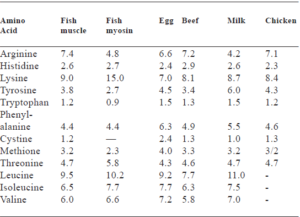
アニメーション NS l NS roteins
NS は NS 食事 : Fish meal is the ideal protein item having all the essential amino acids required in fish feeds. It has been reported that fishes feed with fish meal have yielded better results when compared to the fishes fed with soyabeen.
NS ilk w また NS NS 上 NS e : In Japan intensive farming of carps in cages and floats is achived by feeding with silkworm pupae and the conversion rate worked out to 2. It has been revealed that fishes fed on silkworm pupae have yielded better growth when compared to the fishes fed on a mixture of rice bran and mustard oil cake in the ratio 1 :1. It has been observed that a mixture of animal proteins gave better weight grain and feed conversion than a mixture of plant proteins or any of the proteins tested alone. It has also been reported that plant proteins mixed with 10 to 15% of animal proteins could be utilized as the basic ingredients in formulating the artificial feeds under intensive fish farming.
プラ NS NS NS roteins
They are deficient in lysine and methionine content, and to avoid aminoacid imbalance need supplementation with animal protein. The most favoured items generally used for carp feeding are different oil cakes, and grain fodders. It has been reported that in the composite fish culture of Indian major carps and exotic carps high fish production has been achieved by using a mixture of rice bran and mustard oil cake in the ratio 1 :1. The nutritive value of oil cakes and grain feeder is dependent on their quality. The quality of prepared feeds will be reduced when their fact content is 10-20%. The overall protein content will be used when the solvent extracted oil cake and rice bran are used as feeds.
L ea NS NS roteins: Information regarding the use of leaf proteins in fish nutrition is, as yet, negligible except for somevegetable eating species, but because of their high production and competitive economy in agricultural industries, they may in the near future occupy a prominent place in fish feeds after adequate processing involving separation of pigments, flavour and toxins.
Alga e NS roteins: Algae constitutes the feed of certain varieties of Cultivable fishes. Chlorella spp. have been found to contain all the essential amino acids and protein of desired nutritional and functional and functional quality can be obtained by selecting the suitable media for their culture and adjusting the harvesting time. It has been noticed that feed pellets made of Chlorella resulted in the higher yields of Oreochromis mossambica.
Singl e セル l NS NS o teins : the proteins derived from yeast, bacteria, fungi or algae grown on a variety of substrata, which include hydrocarbons like crude oil, gas oil, natural gas, coal, carbohydrates such as cellulose, grain, sulfite liquor, molasses and organic wastes constitute yet another source of protein. It has been reported that satisfactory results are achieved when yeast is grown on liquid hydrocarbons as a substitute for a part of fish meal.
カルボ NS ydrat e NS
They are diets of starch and serve as a major source of dietary calories in artificial feeds. Most of the cultivable fishes like carps and mullets are omnivorous taking in considerable amount of vegetable matter and are therefore, well adapted physiologically to digest starch. Digestibility of starch is reported to be 30-90%. Rice bran and wheat bran which are the main starchy diets used for cultivable fishes are found to the highly digestible. Potatoes can be used as substitute for grain. It has been reported that the digestability of potato starch, xylan and algin as 85, 66 and 53% respectively. The ratio of protein to carbohydrate in the feeding of 1 :7 or 1 :8 which gives a wide scope to utilize feeding of cheap carbohydrate diets as long as protein in the natural food is sufficient for growth. While formulating the balance diets, carbohydrate and protein ratio needs a careful manipulation so as to spare the proteins for growth and carbohydrate to serve supplying the dietary calories. The diet of certain fishes is said to be nutritionally complete when it contains 39.9% of proteins and 18.2% carbohydrates with food conversion rate of 1. 4-2. 4:1.
NS で NS
The fishes cultivated in warm waters utilize the fats in a better way. Stimulation has been noticed in the growth of fishes when cod liver oil is added to the diet. But it is known whether lipids or other components of the oil are responsible for such a type of stimulation of growth. As excess fats get deposited in liver, trout ration is usually prepated with less than 10% fat content. It has been reported that in order to yield better results of growth and to reduce mortality in rainbow trout fatty acids with Omega-3 configuration between 3-10% are required. The increased fish yield was found maily due to accumulation of body fat in sorghum fed fish as long as protein was not a limiting factor. Therefore it is clear that provided the protein component in the diet is sufficient, fats can be advantageously used in carp feeds for gaining added yields as well as sparing proteins for growth.
Mi NS ro NS ut NS NS NS NS NS
The growth stimulating micronutrients cannot be substitute for food but their presence in general required to formulate a balanced diet for improving the protein assimilation. In spite of the presence of proteins, growth rate may be slow due to the absence of micronutrients.
V 私 tamin NS
Salmon and trout require all the seven vitamins for their growth. Cultivae carps need pyridoxine riboflavin and pantothenic acid. The carps indicated better results when they werefed with 0.8 mg/kg/day of cobalt, which is a part of vitamin B12 concerned with nitrogen assimilation and synthesis of haemoglobin and muscular protein and addition of 4% fodder yeast. Addition of cobalt chloride increases the survival and growth of cultivable fishes.
NS NS tibioti NS NS
The intensive fish farming results in causing diseases to fishes. The role of antibiotics in stimulating protein metabolism depends upon the quality of diet and best results have been obtained by feeding 20, 000 units of terramycin to carps every three days resulting in the growth increase by 9.5% and a fodder saving of 10.5%.
Digestibili NS y
Natural food items of fishes are highly nutritious, reflecting a simple and regular relation between protein, fat, carbohydrate and their utilization, but in case of artificial feed stuff, elaborate experimental analysis have to be carried out to know their digestibility and utilization co-efficients. Digestion co-efficients are generally measured in terms of nitrogen and calories.
NS エル NS ti o ns NS 私 NS NS et w ee NS NS o NS NS NS NS NS rowth
Food supply is the most potent factor affecting the growth of fishes and with sufficient quantity and adequate quality of food, fish attain the maximum size. It is not easy to measure accurately the food intake of fishes.
Some of the food is used to replace the tissues broken down in catabolic processes i.e., to provide for basal metabolism. Basal metabolic rates can be measured by studying the respiration of anaesthetized fish. The activities of fish is influenced by the environmental conditions and requires energy. The energy for these activities is obtained from food. Fish can gain weight only when they eat more food than is necessary to satisfy their basal metabolism and to provide energy for their activity. The fish require particular ration for the upkeep of the routine metabolism known as maintenance requirement. Fish only gain weight from surplus food after fulfilling the maintenance requirements. In case of food shortage, fish lose weight, and in case of starvation the metabolic activities are lowered to some extent.
The use of vitamin B12, cobalt nitrate and extract of ruminant stomach give good results in survival of the major carp fry. It is found that 50 kg B12 and cobalt nitrate in combination with extract of goat stomach enhance the survival of carp fry upto 5%. Addition of yeast, also promotes growth. Yeast along with vitamin B12 and B-complex also enhance the survival rate significantly. The knowledge of conversion rate is very essential for the selection of fish feed. The conversion rate is expressed as a ratio between food consumed for increase per unit weight gained by the body discounting the food requirement by the for its maintenance and energy requirement.
Quality of feed Conversion rate =Weight increase (flesh) 6.8 Supplementary 給餌
In the raising of stable fishery, there is a need for regular supply of sustained and balanced food for growin fish. Suitable food has to be provided for healthy growth of fish. Special food arrangement is required for raising good crop of quality often very necessary.しかし、 artificial feeding of fish in rearing and stocking ponds may not be economical in India at present. Some fattening food may, しかし、 be desirable a few days before the harvesting and marketing of fish. To ensure sustained growth, artificial food has to be supplemented at times of natural food scarcity in ponds.
The food which is added in the pond for better growth of fish is supplementary food. The typical supplementary foods are rice bran, groundnut oil cake, bread crumbs, fish meal, maize power, broken rice, soyabean cake, peanut cake, corn meal, cottonseed oil cake, oats, barley, rye, ポテト、 coconut cake, sweet potatoes, guinea grass, napier grass, wheat, silkworm pupae, left-over animal feeds and animal manures.
The kind of extra food depends on the type of fish. For example tilapia eat almost anything including all types of supplementary foods. The silver carp eat only phytoplankton, even at the marketable size.
Supplementary feeds given to different cultivated fishes of diverse feeding habits are:
- Vegetable feeds such as leaves, grasses tubers and roots starches.
- Oil cakes such as mustard, groundnut, til, coconut etc., and other residues.
- Grain fodders like wheat bran, ご飯、 lupine, soyabean, トウモロコシ、 rye, barely etc.
- Feeds of animals origin such as fish flour, fish meal, fresh meat from warm blooded animals blood, poultry eggs shrimps, crabs, ムール貝、 snails etc.,
- Additives such as vitamins and minerals.
Fish may also feed directly on dung applied as manure in ponds. The selection of supplementary feed depends on number of factors such as:
- Ready acceptability to fish
- Easy digestibility
- High conversion value
- Easy transportability
- Abundant availability
Of all these, ready acceptability by the fish and its conversion ration and the involved costs are the most important. It should be a balanced one with adequate protein, fat, carbohydrate, mineral and vitamin contents. The rate of food conversion depends on:
- quality of supplementary feed
- stocking density of fish
- size and age of the fish stock
- environmental factors such as temperature, oxygen tension, water etc.
- The method of feeding (the spreading and frequency of distribution etc.)
In the raising of stable fishery, there is a need for regular supply of sustained and balanced food for growing fish. Suitable food has to be provided for healthy growth of fish. Special food arrangement is required for raising good crop of quality often very necessary.しかし、 artificial feeding of fish in rearing and stocking ponds may not be economical in India at present. Some fattening food may however, be desirable a few days before the harvesting and marketing of fish. To ensure sustained growth, artificial food has to be supplemented at times of natural food scarcity in ponds.
The food which is added in the pond for better growth of fish is supplementary food. The typical supplementary foods are rice bran, groundnut oil cake, bread crumbs, fish meal, maize powder, broken rice, soyabean cake, peanut cake, corn meal, cottonseed oil cake, oats, barley, rye, ポテト、 coconut cake, sweet potatoes, guinea grass, napier grass, wheat, silkworm pupae, left-over animal feeds and animal manures.
Relati o nshi NS betwe e NS sup NS lemen NS ar y NS e e NS NS NS fis NS 製品 u ctio NS の 違う 文化 システム
In the natural environment, when the growing fish number and natural fish food organisms are in equilibrium, it is need not necessary to provide supplementary feed. When the culture system is intended to go in for more fish production, fertilizers and supplementary feeds should be supplied. In the extensive culture system, the fish production can be
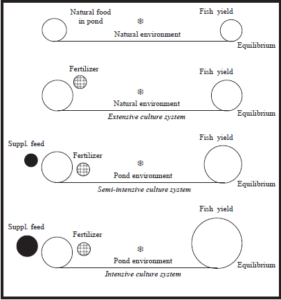
Relationship between supplementary feed and fish yield.
enhanced by adding little amount of organic and inorganic fertilizers, whereas in semi-intensive culture systems the fish production can be enhanced by adding the fertilizers along with sufficient amount of supplementary feed. In intensive culture systems the fish production can be enhanced more by using large amount of supplementary feeds (Fig).
The fish yield can be enhanced by increasing the supplementary feed from the extensive to intensive culture practices (Fig).
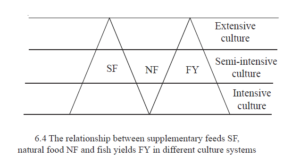
NS o rmulate NS 手数料 NS
Rearing of spawn, fry and fingerlings until they become stockable size and their subsequent culture in grow out ponds require appropriate and nutritionally balanced diet for enhancing production. This has been one of the essential requisites in the development of aquaculture. The advantages of formulated feeds are:
1. Proper formulated feeds are a replica of exact nutritional requirement of fish.したがって、 by understanding the nutritionally well balanced feeds which could be formulated using low cost feed stuff availability locally.
2. Ingredients of formulated feeds can complement one another and raise the food utilization rate.
3. Proteins can supplement one another so as to satisfactorily improve most of the essential amino acid content of the feed, thereby raising the protein utilization.
4. Large quantities of feeds can be prepared at a time with good shelf-life so as to be convenient to preserve, which can be used at the time of supplementary feeding.
5. Feed ingredient sources can be broadened with preferred and less preferred ingredients along with additives like antibiotics and drugs to control fish diseases.
6. High efficiency of feed can be achieved by judicious manipulation of feed ingredients and can be made commercially feasible.
7. By adding a binding agent to produce pelleted feeds, the leaching of nutrients in water is diminished and wastage is reduced.
8. Dispersing over large farm areas is quite possible as formulated feeds are convenient to transport. These are suitable for automatic feeding, for which automatic feed dispensing devices could be successfully employed.
Formulated feed are mainly of two types. They are:
a) Suspension – It is liquid feed, prepared with Acetes, Squilla and clams. Its preparation is discussed in chapter VG.
b) Pelletised feed – This is a nutritionally well balanced solid feed and can be used off the shelf as and when required. This type of feed contains only ingredients of precisely known composition and for this reason such diets are very expensive.
にとって NS ulatio NS o NS フィード :
Though natural fish food is available to fish, supplementary feeds are required to get more yield. The supplementary feed is a combination of different ingredients both from plant and animal origin and it can be administered in different forms. The conventional method is by broadcasting the feed in dry powder form in the fish pond. Broadcasting has its own disadvantages. Much of the feed is likely to be wasted by getting dissipated in water due to the disturbance causes during the feeding of fish. Further, supplementary feed in powder form can not be stored for a longer period. Alternatively, the feed is given in paste form. To avoid the instability of these ingredients, the feeds are now prepared into dry type of pelleted feeds. Dry pellets are easy to handle and store, have longer shelf-life and are free from accumulation of lethal toxic materials like alpha-toxins. Further, such pellets reduce wastage on feeding and ensure uniform composition of the various nutritional components. Owing to these advantages, the fish culturists are assured of maximum return when they use dry pellets.
The ingredients used for formulating fish-feed should be based on their qualities such as protein content, energy level, type of amino acids, etc. Major ingredients commonly used are corn meal, groundnut oil cake or mustard oil cake, soyabean powder, rice bran, wheat bran, fish meal, fish offal, shrimp meal, crab meal, blood meal, slaughter-house waste, tannery waste, silk worm pupae, cow dung, tapioca flour, wheat flour, wild leguminous seed kernels, dried algae, molasses, etc. Besides, dried yeast in the form of flour also serves as a rich food ingredient with protein and many B-group vitamins.
In many fish feeds, protein is the most expensive portion and is invariably the primary substance. The energy level of the diet is adjusted to a desired level by the addition of high energy supplements, which are less expensive than protein supplements. The rectangle method is an easy way to determine the proper dietary proportions of high and low-protein feeds for use in the dietary requirements of fish.例えば、 if rice bran and groundnut oil cake are to be used as chief ingredients to prepare fish feed with 40% protein, the procedure is as follows:A rectangle is designed and the above mentioned ingredients are put on the two left corners along with their protein contents.
The desired protein level of feed is placed in the middle of the rectangle.次、 the protein level of the feed is subtracted from that of the already used ingredients placing the answer in the opposite corner from the feed. This could be elucidated by an example. That is, for the preparation of 36.8 kg of fish feed with 40 percent protein, 3.5 kg of rice bran and 33.3 kg of groundnut oil cake are added. In other words, for the preparation of 100 kg of fish feed with 40 percent protein, 9.5 kg of rice bran and 90.5 kg of groundnut oil cake are needed.
NS 賠償 o NS pe l レテ NS fis NS NS eeds :
The required quantities of the various components are dried, powdered and mixed. The mixture is kneaded well adding minimum quantity of water to form a soft dough. The dough is then cooked for 30 minutes in steam under pressure at 1 kg/cm2 (15 lbs/inch2). The dough after cooking is allowed to cool in a spacious tray and the prescribed quantities of chap fish oil or vegetable oil and vitamin and mineral mixture are thoroughly mixed in the dough. Finally, it is pressed through a hand pelletiser having a perforated disc with 2 mm or larger holes depending on the size requirement for different finfish and shellfish. A semi-automatic pelletiser powered by a 0.25 HP electric motor suitable for the production of pelleted fish feed having a rated output of 10 kg/hr has been designed. The noodles are dried in the sun and broken into pieces of about one cm, Care should be taken to see that the pelleted feeds are free from moisture.しかし、 a maximum moisture content of 15% may be allowed in the pellets. Sun-dried pellets can be stored for a period of even one year.
おとこ NS geme NS NS o NS 手数料 NS の NS
Proper management of feeding in aquaculture practice is important for resulting in maximum yield, feed utilisation efficiency and to reduce the waste of feed as well as the cost incurred for feed to a certain extent. The management of feeding involves the feeding rate as well as the frequency of feeding at a fixed place and fixed time. These feeding rates and feeding frequencies vary with the species, size of fish, water temperature and dietary energy levels in the feed (Chiu, 1989)。 Usually the feeding rate is adjusted either at a given percent of body weight. The former feeding rate is very common and prevalent. Feeding frequency is also positively related to the growth of fish. Fish either at short food chain at low trophic niche or at the higher feeding regime naturally grow faster although there is a maximum ingestive limit at which the increase in growth is negligible. This is defined as the optimal feeding frequency which differs from size offish, sex, gut morphology of the species and meal size of the artificial feed.
The feeding management concept of fixed quantity and quality is to be oriented as the daily food consumption in fish is variable. Such daily variations in feed intake is bound to influence the digestibility of the fish.したがって、 the management of feeding schedule should match with the diurnal variations of digestibility of the fish for proper feed utilization and assimilation efficiency.したがって、 mixed dietary regimes of low and high protein in feeding can provide a means of reducing feed costs and marginal cost of fish yield.
NS u ppl e 男性 NS ar y 手数料 NS の NS 私 NS NS urs e NS y NS ond NS
Though carp hatchlings predominantly feed on minute plankton, yet the supply of supplementary feed in the form of finely powdered 1:1 ratio of groundnut oil cake and rice bran to the hatchlings or fry results in better growth in nursery pond. The nursery ponds are supplied with supplementary feed equal to double the weight of spawn from the first to fifth day and then the amount is doubled till fifteenth day. Feeding should be stopped a day before harvesting. The feed should contain 40-45% protein, 25-30% carbohydrate. Cobalt in minute quantities of 0.01 mg/fish/day along with supplementary feed enhances the survival and growth rate of hatchlings. The mixture of silk worm pupae, groundnut oil cake and wheat bran in rohu and mrigal, and soyabean in catla cultures gave good results.
NS upp l eme NS タール y NS e edi NS NS 私 NS NS 耳 私 NS NS NS ond NS
The fry are provided with supplementary feed in the form of groundnut oil cake and rice bran at the rate of 1% of the body weight till they grow to fingerlings.
スー NS plem e ntar y fe e din NS 私 NS stoc k の NS 池 NS
The supplementary feeds like oil cake and rice bran must be supplied to the fish in stocking ponds. Oil cakes like mustard or groundnut and rice bran in 1:1 ratio should be given to fish daily at the rate of 1-3% of the body weight. Aquatic weeds are given to grass carp. Feeding is carried out preferably in the morning hours. It is always better to assess the density of plankton before feed is supplied. If the plankton is below 2 ml/50 1, only then the supplementary feed should be given. The feed should be supplied at a fixed place in a tray suspended in the water. The grass carp should be given aquatic weeds on a bamboo platform.
NS ええと NS ar y
A variety of natural fish food organisms are found in a waterbody, which depend on the nutritive nature of the waterbody. The natural food provides the constituents of a complete and balanced diet.
The natural fish food organizims are plankton, oligochaetes, insects larvae, molluscs, tadpoles, weeds, NS。
The plankton is divided into two main categories – phytoplankton and zooplankton.
The phytoplankton drift about at the mercy of the wind and water movements. Algae consist of three major classes which form the main food in phytoplankton. These are chlorophyceae, cyanophyceae and bacillariophyceae.
The most common organisms in zooplankton are protozoans, crustaceans and rotifiers
Bioenrichment is the process involved in improving the nutritional status of live feed organisms either by feeding or incorporating within them various kinds of materials such as microdiets, microencapsulated diets, genetically engineered baker’s yeast and emulsified lipids rich in w3HUFA (Highly Unsaturated Fatty Acid) together with fat soluble vitamins.
Food supply is the most potent factor affecting the growth of fishes and with sufficient quantity and adequate quality of food, fish attain the maximum size.
The food which is added in the pond for better growth of fish is supplementary food. The typical supplementary foods are rice bran, groundnut oil cake, bread crumbs, fish meal, maize powder, broken rice, soyabean cake, peanut cake, corn meal, cottonseed oil cake, oats, barley, rye, ポテト、 coconut cake, sweet potatoes, guinea grass, napier grass, wheat, silkworm pupae, left-over animal feeds and animal manures.
Formulated feed are mainly of two types. They are:
a) Suspension – It is liquid feed, prepared with Acetes, Squilla and clams. Its preparation is discussed in chapter VG.
b) Pelletised feed – This is a nutritionally well balanced solid feed and can be used off the shelf as and when required. This type of feed contains only ingredients of precisely known composition and for this reason such diets are very expensive.
Source:AquaCulture

